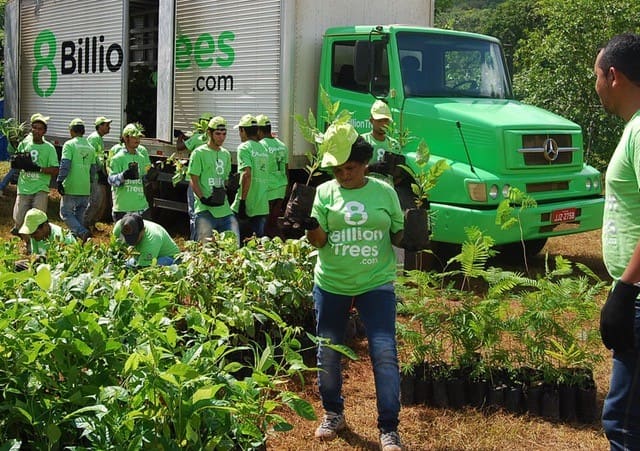Hello Jon! Please tell me who you are and what inspired you to work for 8 billion trees?
My name is Jon Chambers, and I am the founder of 8 Billion Trees, which we launched in 2018 as the world’s population was nearing eight billion people. Inspired by activist groups, we had a simple idea: if people can destroy the earth, they can work together to rebuild it, too. Using trees as our magic solution (they really are amazing), we began to reforest devastated areas while also focusing on protecting existing trees and rehabilitating wildlife.

How long have you been with the company?
As the founder, I have been here since we started. We have no plans of slowing down and are working hard towards living out our passion of healing the planet and saving animals.
What is your role in the company?
While I engage in most areas of our organization, I have found the most fulfilment in being a part of the reforestation operations themselves, collaborating with our teams of planters throughout sites in the Brazilian Amazon and experiencing first-hand the impact we can all make by simply taking action.
What is the purpose behind the specific goal of planting 8 billion trees?
The goal comes from the idea of one tree for each person. It’s a belief in the idea that everyone can truly make a difference for the planet, and no one should feel hopeless. If each and every person was committed and confident, they could have a positive impact. Just imagine what we could accomplish towards the climate crisis! That’s the sort of team spirit we’re hoping to spur with our goal of planting eight billion trees.
What do you do in your personal life, aside from work, to live a sustainable life?
Ultimately, the biggest impact anyone can make is to use less, consume less, and reuse more. The three biggest drivers of personal emissions are home energy usage, personal transportation, and diet – that is where I try to focus my efforts.
What advice would you give to a regular person trying to be more sustainable?
You don’t have to make massive changes overnight. Even building small habits like turning off lights, opening windows to avoid using home heating and cooling, and riding a bike instead of driving whenever possible add up. We always encourage people to find their carbon footprint before making changes so they can calculate it again after and see how they did. It really does add up!
On your website, it’s mentioned that you conduct large-scale operations, what is your favourite ecosystem to work in, and why? -e.g.: forest, jungle, rainforest, etc.
While it is particularly important to focus on reforestation efforts all around the world, where they are desperately needed, my personal favourite would be the Amazon Rainforest. It is such a living and breathing ecosystem with an awe-inspiring size that really makes you appreciate how amazing the planet is. Every time I visit our planting sites, it recharges my passion for the planet even more and reminds me of why our team is working so hard.

Please tell us a bit about how you analyse the sustainability of your partners, such as the animal sanctuaries. What are the criteria for a partner to be accepted?
Most of our partners are government agencies. This ensures that what is being done not only has a prominent level of transparency, but also a high level of permanence. What we’re doing is going to be around tomorrow and for years to come. We form contractual agreements with them that allow our team to work in devastated areas, while at the same time protecting them from future deforestation.
The handful of partners we work with that are not government officials have proven themselves through decades of accountability; we constantly monitor their progress with detailed reports so we can make sure we’re all progressing towards the same goal of planting more trees the right way.
Again, on your website, it mentions you want to become the most environmentally aware social enterprise on the planet.
Can you please tell us about some of your inner-company initiatives to achieve this goal? What programs do you offer your employees and volunteers, and how can other organizations follow you? What other ventures do you compare yourselves to?
At its core, this means we want to help spread the knowledge that profit does not need to come before caring for the planet. In fact, many consumers are beginning to demand environmental responsibility from the services and products they consume. Our organization wants to stir this awareness to show companies that by helping the planet, they can have not just a bigger monetary impact but help heal the planet and save animals as well.
While our planting teams are obviously engaged in reforestation efforts year-round, elsewhere we host planting days. This is when we go out and plant trees in the local community. While we haven’t included a way for volunteers to get involved in those planting days, I think that is an amazing idea and something on which we should work. However, at certain planting sites, we encourage and host local university students to volunteer. We also supply sustainability gear to all our employees and have regular carpools.
Every little bit helps – organizations just have to start and improve over time!
Have you currently worked with governments to implement your mission on a larger scale? Why or why not?
Mentioned earlier, we’ve found that working with governments allows us to have not just a deeper impact but one that will last. It also allows us to gain the support of local communities while educating the local population on reforestation and showing them that they don’t have to cut down the forest to survive. Instead, they can help plant and protect trees while actually providing for themselves and for their families, even better than they would by cutting down trees.
On average, how many trees are planted per purchase? And during a month?
The number of trees planted depends on the carbon offsets needed for any given person. We provide tools like ecological footprint calculators and guides to carbon offsets completely free for anyone to use. We offer the ability to become carbon neutral through planting the right number of trees for them.
When it comes to planting trees, some species can only be planted during certain seasons; during the “off season” in those locations, we focus on growing saplings in our nursery networks. Once the rainy season begins, we are ready to plant!
Aside from donations, how can people help?
The number one-way people can help is by spreading awareness about the crisis and helping educate others about the increasing deforestation our planet is facing. Individually, tracking their footprint over time and finding ways to lower their emissions is important as well. Mentioned earlier, we are a big believer that everyone really can make a difference.
All it takes is the desire to do so, and slight changes over time!
What is the best way people can help combat deforestation to begin with?
Simply put, use, and consume less. Deforestation is largely driven by consumer demand.
What do you do to engage the local communities in your projects?
Mentioned earlier, the main way we have found to successfully do this is through gaining the support of government officials and community leaders. This gives us the privilege of collaborating directly with local communities, while also gaining their trust. This enables us to collectively make a bigger impact together. It also allows us to learn from amazing groups of people from all around the world!
Is there anything else you’d like to share or add?
To anyone reading, don’t feel hopeless.
The climate crisis can certainly leave us feeling down when we look at recent numbers and figures, but we must remember that more people every day are becoming aware of how their personal actions affect the climate.
As this awareness grows and more people take action, we can start to turn the tide for a greener, brighter future for all of earth’s inhabitants.





Love this interview, very inspirational!! Trees really are amazing 😉
Thanks Pauline! These people and what they are doing is amazing and we should give our support to them!
I agree so much… We should keep up hope, and try to improve ourselves & each other. Amazing project.
Yes, indeed! It’s amazing!
Hey Jon! Love your passion for trees. How about focusing on quality over quantity?
Hey there! I appreciate your enthusiasm for trees, Jon. Just wanted to suggest that focusing on quality over quantity might help us preserve their beauty and value. Keep up the good work!
Jon, youre doing an amazing job! How about planting 9 billion trees instead?
Jon, your passion for planting trees is inspiring! How can we get involved?